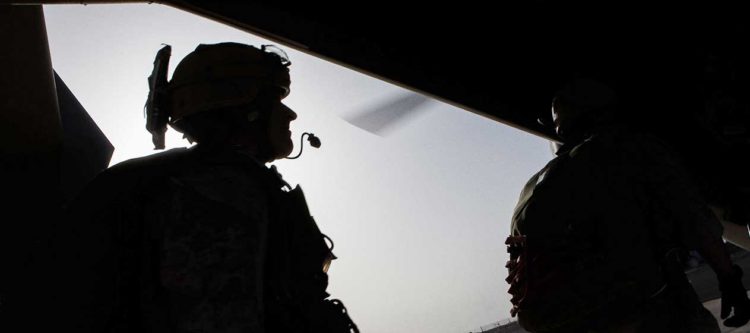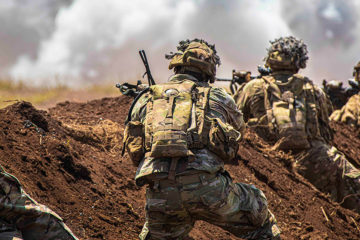SYANS on the growing role mesh networks are playing within special operations

No matter if it’s a warfighter deployed on a special operation in an off-grid environment, or an emergency responder in a dense urban area with weak cellular connectivity, having reliable means of communication and situational awareness is critical for a mission to be executed successfully. But in these environments where traditional, terrestrial networks are weak, compromised, or non-existent, operators are now turning to new, innovative solutions and technologies to meet their mission-specific, connectivity requirements.
One emerging technology that is becoming widely adopted by off-grid, special operators, and emergency responders is the mesh network. Mesh networks provide mission personnel with a reliable source of connectivity that operates independent from traditional networks or cell towers, enabling seamless communication and situational awareness among all mission crew members.
To learn more about mesh networks, as well as the critical roles communications and situational awareness play in effective special operations, The Last Mile sat down with Jérôme Souverain, Director of SYANS, a French-based security technology company that specializes in surveillance solutions, UAV/UGV, and transmission systems.
Here is what he had to say:
The Last Mile (TLM): Can you tell our readers a bit about SYANS and what the company does? What types of organizations does the company support?
Jérôme Souverain: SYANS is a French company that has been in operation for more than 10 years now. We have gained recognition within the security and defense communities for our innovative, special operation security technologies.
We partner with many major international organizations and are well known for the quality of products we market, the integrity of our employees, and the care and discretion we provide to all our customers.
“Mesh networks facilitate autonomous, closed, reliable connectivity based on the simple concept that the more personnel there are deployed across a specific mission zone, the greater the connectivity surface area that is covered.”
– Jérôme Souverain
With SYANS’ in-depth knowledge of the current security threat landscape and our expertise in special operations, the company has fostered and cultivated trust with our customer base that extends far beyond just business. This philosophy permeates all levels of our company, and SYANS continuously seeks to provide ‘the right answer’ with the most suitable solutions for the demanding needs of special operations.
TLM: What role do communications play in effective intelligence, special ops, and anti-terrorism missions? Why is assured comms so important to these missions, in particular?
Jérôme Souverain: From receiving and relaying intelligence, to dispatching orders during mission execution, assured comms plays a critical role in the success of an operation. If operators and mission team members have unreliable network connectivity, command and coordination are impeded, creating major challenges for tactical execution.
Therefore, there needs to be a reliable communication network that is completely independent from existing infrastructure. It also needs to be difficult to infiltrate, and it must ensure a seamless and successful operation.
Mobile mesh networks meet all of these requirements, and on a much bigger scale than just military-specific operations. It can also be employed by search and rescue teams during emergency and disaster response efforts.
For example, if after a hurricane the existing communication infrastructure has been severely damaged or compromised, a mesh network can still keep all mission team members connected, which ultimately enhances response, increases the chances of a successful mission, and saves lives.
TLM: How can the situational awareness and communications capabilities offered by mobile mesh networking help in these missions?
Jérôme Souverain: Mesh networks facilitate autonomous, closed, reliable connectivity based on the simple concept that the more personnel there are deployed across a specific mission zone, the greater the connectivity surface area that is covered.”
This translates to greater information exchange between mission team members who are wearing or carrying mobile mesh devices. Information can also be sent back to command in near real-time. Each mesh device simultaneously serves as a transmitter, receiver, and relay, allowing for the transmission of information between two out-of-range units that are within the mesh signal range.
The goTenna Pro X is a leading mobile mesh operating device for situational awareness and communication in off-grid operations. With a goTenna device, operators can keep track of every team member’s location, and mission command is able to have a global view of the deployed unit. Mission command’s ability to direct the execution of an operation is a key element of optimizing and allocating resources in real-time.
“From receiving and relaying intelligence, to dispatching orders during mission execution, assured comms plays a critical role in the success of an operation.” – Jérôme Souverain
goTenna devices also support private communication between operation personnel via text messaging. Text communication is a great comms alternative when radio resources are unavailable. It also helps to avoid oversaturating mission commands with non-urgent messages. This has proven to have significant, positive impacts on special operations by saving a great deal of time and resources during mission execution.
The goTenna Pro X also offers situational awareness and location tracking capabilities through a digital map interface that provides robust, real-time mission information. Military personnel commonly pair the goTenna Pro X with other tactical execution mobile applications like ATAK, DELTASUITE, and AGENA-LEADER, which gives them an undeniable operational advantage during missions.
TLM: Mobile mesh is often considered difficult to detect, as they use short burst communications that are difficult for adversaries to identify. How can this be useful in anti-terrorism and special operations missions?
Jérôme Souverain: As I mentioned earlier, a mesh network is extremely difficult to detect and penetrate. The answer lies in your question: as long as communications are reliable and secure, a military leader can continue to command and the mission can proceed. For special operations, personnel are often on their own, executing a mission deep inside enemy lines, and cannot rely on immediate reinforcements or backup.
A mesh network has a small ground footprint and facilitates continuous communication and coordination between team members. Therefore, the unit naturally has a tactical advantage over an adversary who is solely relying on a traditional network infrastructure.
“…there needs to be a reliable communication network that is completely independent from existing infrastructure. It also needs to be difficult to infiltrate, and it must ensure a seamless and successful operation.” – Jérôme Souverain
One aspect of a mesh network that is not highlighted enough is the significant increase in operation security. An operator can trigger an alert on the network in response to even the slightest problem. This alert takes precedence over any ongoing actions, and intervention to assist can be immediate, significantly reducing response times.
TLM: Do you have any anecdotes or examples of how mobile mesh has been used or tested by your customers in the field?
Jérôme Souverain: Out of respect for my customers’ confidentiality, allow me to approach your question from the viewpoint of rescue units only. I do have access to feedback from those customers’ experiences and the conclusion is unanimous: the goTenna Pro X adds value to the execution of operations.
What is particularly interesting is just how imaginative operators can be in the field. How they manage – using this communication platform – to expand and optimize the system’s capabilities. One experience comes to mind: a mission in a dense urban area filled with high-rise buildings. The signal was not optimal; the working distance was therefore reduced. The operators attached a goTenna device to a drone, switched it into relay mode to create a bubble which then increased working distances and improved information exchange.
To maintain connectivity, operators climbed onto the roofs of the tallest buildings and installed goTenna devices along with long-life battery packs, which kept the network running smoothly for three days.
I can also confirm that a military operation was successful thanks to the goTenna Pro X. The mission orders were relayed via the text messaging function in an operational area where there were no traditional, terrestrial networks.
To learn more about Syans, click HERE.
To learn more about the importance of remote situational awareness for special operations forces, download the whitepaper HERE.







No Comment